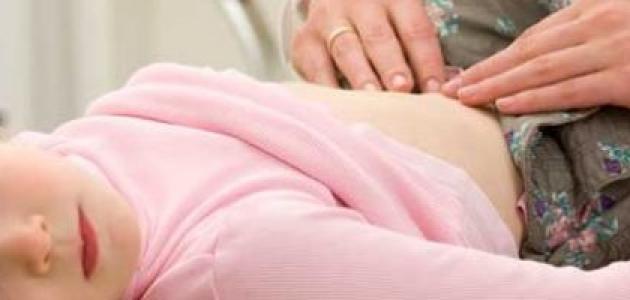Appendicitis in children
The appendix, or what is also called the appendix, is a hollow tube closed on one side, and connected on the other side to the first part of the large intestine, which is called the cecum, and its length ranges from The appendix is between 8-10 cm in normal condition, and its width usually does not exceed 1.3 cm. The cavity of the appendix is as narrow as possible where it meets the cecum. No specific benefit or function of the appendix has yet been known, but some hypotheses indicate that it contains bacteria. Beneficial for the digestive system, and may contribute to the production of cells belonging to the endocrine system in the fetus, in addition to the possibility of playing roles in the function of the immune system in the human body, in the first three decades of its life.
Appendicitis is one of the most common causes of abdominal pain, especially in children. It also represents the most prominent surgical emergency, as it must be assumed to be present in any patient who complains of abdominal pain. It must also be diagnosed and treated quickly, as the chance of appendicitis increases. The inflamed appendix bursts over time. The chance of developing appendicitis is about 12% in males, but it doubles to approximately 25% in females. A person may develop appendicitis during different age stages, but most cases occur between the ages of ten and nineteen. Of age.
Read also:Motor development of the child
Symptoms of appendicitis in children
There are many signs and symptoms resulting from appendicitis in children, and they may differ from one case to another. There is no typical clinical picture caused by appendicitis. Among the common symptoms and signs that may indicate appendicitis in children, we mention the following:
- Severe abdominal pain: The location of feeling the pain may vary. The patient may feel it around the navel, above the stomach, or in the middle of the abdomen, and the pain moves to the lower right part of the abdomen, a few hours after feeling the initial pain. This pain gets worse when coughing or making a movement. It should be noted that the anatomical location of the appendix may differ from one person to another, which leads to a difference in the location of pain depending on the location of the appendix. If the appendix is located behind the cecum, the patient may feel pain when it becomes inflamed in the back or flank. As for the pelvic appendix (in English: Pelvic appendix, which causes pain in the suprapubic area.
- Gastrointestinal symptoms: Such as nausea, vomiting, and loss of appetite (in English: anorexia), and these symptoms often appear after feeling abdominal pain.
- Burning urine: In addition to noticing blood in the urine (in English: Hematuria); This is due to the proximity of the appendix to the urinary tract.
- High body temperature: The body temperature may rise slightly during appendicitis, ranging between 37.7-38.3 degrees Celsius.
- Pressure tenderness: The affected person may feel pain when pressure is placed on the lower right part of the abdomen, specifically at McBurney's point. These signs are among the most common signs that may indicate appendicitis. Pain may also be felt in the lower right part of the abdomen when pressure is applied. On the lower left part, which is called Rovsing's sign.
- Lumbar sign: (in English: Psoas sign), and this sign is represented by increasing pain in the lower right part of the abdomen, while the patient is lying on his left side, when the doctor extends the patient’s right leg from the pelvic area.
- Stop sign: Obturator sign: This sign is represented by increased pain resulting from appendicitis in the lower right part of the abdomen when the doctor bends the patient's thigh and turns it toward the body.
Read also:Sixth month vaccination
Causes of appendicitis in children
Inflammation of the appendix occurs as a result of obstruction of its lumen, and this may arise as a result of many different causes, such as hyperplasia of lymphocytes in it (in English: Lymphoid hyperplasia), and the accumulation of fecal stones (in English: Fecalith) inside it. Obstruction may also result from the presence of a foreign body in the appendix. Or from the presence of worms in it, and the blockage of the appendix causes an increase in pressure inside its lumen, and it also continues to secrete mucous fluids, which leads to its swelling and worsening of the condition, to include interruption of blood supply to the appendix, and bacterial overgrowth inside it, which in turn worsens the condition of the affected person, and increases The severity of symptoms, which may eventually lead to perforation of the appendix.
Treatment of appendicitis in children
Treatment of appendicitis includes several methods, but the main treatment is to remove it surgically, whether through open surgery (in English: open appendectomy), or through laparoscopy (in English: Laparoscopic appendectomy), and laparoscopic surgery is the most appropriate option for treating appendicitis if equipment is available. This is due to faster recovery after its procedure and lower risk of infection. Before performing the surgical procedure, the doctor gives the affected person some types of antibiotics intravenously, such as third-generation cephalosporins (in English: Third-generation cephalosporins), once in case the appendix is not exposed to perforation. However, in the event of perforation of the appendix, antibiotics must be continued until the patient’s condition stabilizes. The types of antibiotics used in this case include carbapenem, piperacillin with tazobactam, and ampicillin with sulbactam (in English: Piperacillin with tazobactam). In English: Ampicillin-sulbactam), in addition to the doctor prescribing some types of pain relievers.
Read also:Article about children








